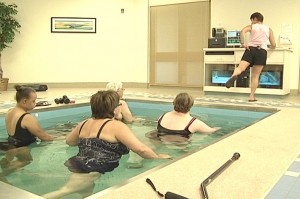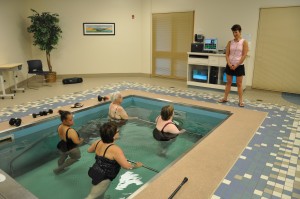Squeezing Out Power Differences, Young and Old
The following blog post is an advertorial piece written by Mary E. Sanders, PhD, FACSM & Cathy Maloney-Hills, RPT.
Mary E. Sanders, PhD, RCEP, FACSM is a clinical exercise physiologist, Division of Wellness and Weight Management in the School of Medicine, University of Nevada, Reno, Director of WaterFit ®/Golden Waves® and advisory board member for the International Council on Active Aging.
Cathy Maloney-Hills, RPT, is an aquatic physical therapist working for Courage Center at Summit Place Senior Campus, Eden Prairie, MN.
Betty, 63 years old, enjoys water walking with her 22-year old daughter Mary in the HydroWorx 2000 pool at Summit Place, in Minnesota. They both have fun walking on the underwater treadmill as they work against the integrated resistance jets. They are doing the same exercise, under the same condition, but are they experiencing the same physiological response?
EMG Studies
Electromyography (EMG) analysis in water provides new insights into how muscles work during submerged exercise. By understanding how muscles are activated in water, trainers are better equipped to tailor exercises to individual needs. To examine muscle activity in water, Kenji Masumoto, PhD, and colleagues at Kyushu University, Japan conducted a series of experiments to measure the percent of maximal voluntary contraction (%MVC), which is the EMG measure of muscle activation during activity.
What Activity Did The Japanese Researchers Measure?
Participants walked on a variable speed underwater treadmill in a therapy pool. Water depth was adjusted for each participant, at about xiphoid (navel to nipple) depth, so the body was unloaded by about 80%. The temperature was a comfortable 31º C (87º F). Variable speed jets could be added to provide added resistance to movement.
Betty vs. Mary. Does Age Make a Difference?
To answer this question, we’ll review one study conducted by Masumoto and colleagues (2). Participants included six older women (63.5 years) and six young women (22 years), who walked on the underwater treadmill described previously. Investigators measured muscle activity, stride frequency and heart rate response. Both the treadmill & water current were set at the same speed during 3 different conditions.
Pace Speed (treadmill & current)
Slow 1.0 mph
Moderate 1.5 mph
Fast 2.0 mph
After practicing, the women walked forward, arms in the water, for 1 minute followed by a 1-minute rest. They repeated the exercise/rest interval for each pace (slow, moderate, fast).
Compared To The Young Women, Did Older Women Exhibit Any Age-related Differences?
Older women took more steps to keep pace, using smaller steps, at both moderate and fast speeds. The older women also activated more of their quadriceps and hamstrings muscles at all speeds and engaged significantly less of the gastrocnemius (calf) muscle at all speeds.
Were There Any Similarities Between Young And Older Aged Women?
The percent of maximal voluntary contraction (%MVC) or muscle activation, increased for all women as walking speed increased. Compared to the “Slow” speed, muscle activation increased as follows:
Speed % MVC
Moderate 67%
High 150%
Heart rate responses were similar for both groups, except at the fast speed where the older women’s heart rate, beats per minute (bpm) was significantly higher compared to young women (99 bpm for older vs. 92 bpm for younger). Also, heart rate responses for both groups significantly increased as speed increased: Heart rates recorded as beats per minute (bpm), with corresponding estimated percent maximal heart rate (MHR)*:
Speed Young Heart Rate (% MHR) Older Heart Rate (%MHR)
Slow 78 bpm (41%) 81 bpm (50%)
Moderate 83 bpm (43%) 88 bpm (54%)
Fast 92 bpm (48%) 99 bpm (61%)
* Maximal heart rate (MHR): 206.9-(age in years X 0.67) = estimated maximal heart rate (1).
Maximal heart rate for the research groups: young = 192 bpm, older = 164 bpm.
What Do These Findings Mean to Betty & Mary?
Let’s generalize the data to Betty and Mary, and apply some of the lessons learned in the study.
Step size and frequency
Betty may benefit from taking larger steps, at slower speeds. Some intervals could include “giant stepping” or “marching” to increase stride length and target dynamic balance.
Quadriceps & Hamstring Activation
Betty may need to consider spending more time at the slower pace to prevent muscle fatigue or include occasional stops for stretch or other exercises. If the objective is cardiovascular conditioning, they’ll both want to be able to complete about 30 minutes of underwater walking, as recommended by the American College of Sports Medicine (1). Incorporating a deep tissue massage from the resistance jets is also recommended at the end of the workout to ease any muscle soreness or lactic acid build up.
Increased muscle activity of the quadriceps and hamstrings may also be due to older adults using increased hip flexion and hip flexor power as they increase gait range of motion. To prevent Betty’s possible hip flexor overuse, encourage neutral postural alignment with ears, shoulders and hips lined up. Cue core stabilizers and include stretching hip flexors to facilitate upright posture and greater hip extension range of motion.
Gastrocnemius Activation
Reduced plantar flexion function associated with aging may result in less power force from the gastrocnemius during water walking. Betty could benefit from intentionally power pushing off the bottom, through the foot (rolling from heel to toe) to stimulate more of the gastocnemius. Cues such as “toes” up during the heel strike help activate the tibialis anterior and provide full range of motion for propulsion. Betty may also want to include hops or skips to specifically train the plantar flexors.
Speed & Muscle Activation
Betty and Mary need to find their own pace to regulate individual muscular overload. To target individual intensities using the same treadmill speed, Betty and Mary could incorporate interval training. Betty could walk forward on the treadmill (maintaining her position in the pool), while Mary moves at a faster pace by traveling from the back of the treadmill to the front. When she arrives at the front, she stands on 1 leg for balance training as the belt carries her back to the start position. Other moves for Mary could include lateral or backward walking.
Participants with fibromyalgia or neurological conditions such as muscular dystrophy need to prevent muscle overuse and should be cued to work at slower speeds.
Heart Rate Responses
For adults younger than 65 years, The American College of Sports Medicine (ACSM) recommends 3- 5 days of aerobic exercise, performed at an intensity between approximately 60-90% of maximal heart rate (%MHR), for 150 minutes per week (1).
Betty and Mary may share similar heart rate responses, but based on their age-related maximal heart rate differences (164 bpm for Betty and 192 bpm for Mary), their individual cardiovascular intensity (%MHR) is different. To meet ACSM guidelines, Betty would have to walk at a “fast” pace (2 mph or faster). At that pace, Mary would need to create additional overload perhaps by performing higher intensity, plyometric exercises such as jumping, or by using tethered resistance to increase intensity.
References
- Bushman, B. (Ed). 2011. ACSM, American College of Sports Medicine. Complete Guide to Fitness & Health. Human Kinetics, www.humankinectics.com/
- Masumoto, K, et al.2007, Age-related differences in muscle activity, stride frequency and heart rate response during walking in water. Journal of Electromyography and Kinesiology, 17, 596-604.
Exercise Program Resource
The Golden Waves®, Functional Water Exercise for Older Adults course by Mary E. Sanders, PhD & Cathy Maloney-Hills, RPT includes: 90 minute DVD (over 50 exercises), 187 page workbook, continuing education online exam (ACE, AEA, YMCA, & more). Contact Desert Southwest Fitness, 1.800.873.6759.



